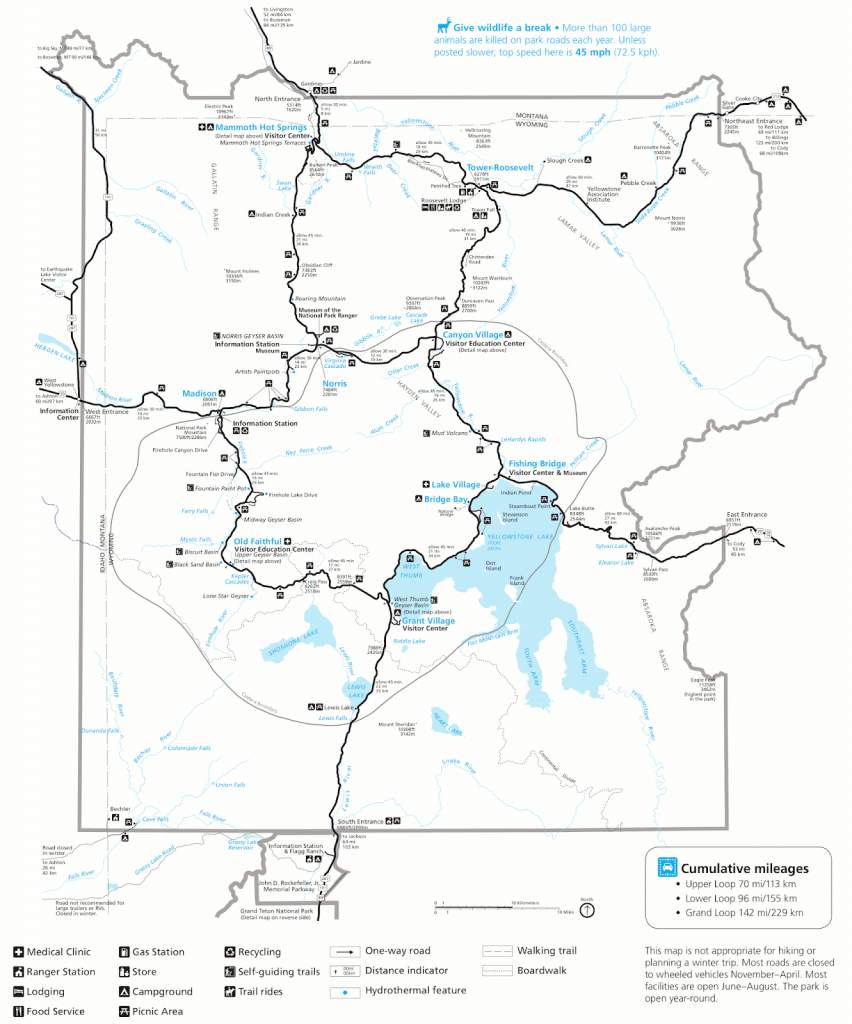
The Best Geysers You'll See in Yellowstone

Oh, the geysers you’ll see!
 Shutterstock Image
Shutterstock Image
Known by such names as “many smoke," "wonderland," and “land of many vapors," the U.S.’s first national park has long roiled, boiled, bubbled, and groaned with hydrothermal activity. But none of these features are as rare and wondrous as its geysers.
Yellowstone is home to over half of the world’s geysers—more than 500 in one park! You could spend a lifetime trying to see them all, but with only a few days? You'll need to know which ones are the best, easiest to reach, and the ones you absolutely can’t miss.
Navigating Yellowstone's Geysers
We’ll start this guide with a quick primer on Yellowstone’s different hydrothermal features—mud pots, fumaroles, and of course, geysers—then break things down basin by basin, moving clockwise around the park.
With a park expanding across 3,472 square miles, you’ll need to know how far away each geyser basin is. Be sure to check the map (below, at Geyser by Geyser) to get an idea of how close/far these basins are from one another.
What’s bubbling in Yellowstone?
Before we dive into the good stuff, let’s break down a few simple terms so you’ll know exactly what you’re looking at (and smelling!) when the ground starts hissing, steaming, and gurgling in Yellowstone.
Geysers
Geysers are the true showstoppers of Yellowstone, with famous features like Old Faithful drawing crowds from around the world. These vents suddenly erupt with towering blasts of steam and hot water, powered by underground reservoirs of superheated water. As pressure builds below the surface, it finally forces its way out—erupting straight into the sky.
Hotsprings
These are like the sleepy siblings of geysers. There’s plenty of hot, bubbling water, but it’s not shooting into the sky—just quietly simmering in place. But don’t let that fool you; hot springs are anything but boring.
These pools glow in emerald, turquoise, sapphire, and gold, thanks to thermophiles—colorful, heat-loving microorganisms that thrive in the hot water. When you picture Yellowstone’s hot springs, think of showstoppers like Grand Prismatic Spring.
Fumaroles
Fumaroles operate a little bit differently than hot springs and geysers. Instead of an underground reservoir that fills with water, fumaroles are vents in the earth that release scalding gases, including carbon dioxide, hydrogen sulfide, and hydrogen chloride. The heat inside these vents is so intense that it flashes any dripping water into steam, creating hissing, or even growling sounds.
Mudpots
If this sounds to you like a pot of bubbling mud, you’re practically ready to become a geologist. Unlike the other hydrothermal features, mudpots, while appearing to boil, may not be particularly hot. These muddy puddles bubble, gurgle, and pop due to hydrogen sulfide gas escaping from underground.
Paintpots are a special variety of mudpots that are colored by minerals. They come in a variety of colors, including pastel pinks, yellows, and grays, and their lively activity makes them a crowd favorite.
Geyser by Geyser, a comprehensive guide
Okay, let’s set off on an imaginary journey to track down all the big-name geysers in the park. We’ll start at Madison Junction, where West Yellowstone—the park’s most popular entrance—meets the Grand Loop Drive. From here, we’ll head clockwise and explore the major hydrothermal features and geyser basins along the way. When we’re done, we’ll end right back where we started at Madison Junction.

 U.S. National Park Service, restoration/cleanup by Matt Holly, Public domain, via Wikimedia Commons
U.S. National Park Service, restoration/cleanup by Matt Holly, Public domain, via Wikimedia Commons
1. Madison Junction
Terrace Spring
This uncrowded roadside hot spring can be a fun first experience with hydrothermal features. The 0.2 mile boardwalk loop parallels a large, deep hot spring in a grassy meadow surrounded by lodgepole pines. The boardwalk itself is flat, with no stairs or steep inclines.
Beryl Spring (Must See!)
 Image from Flickr by Penny Higgins
Image from Flickr by Penny Higgins
Beryl Spring is an unforgettable early stop on your way to Norris Geyser Basin. Its bright blue color is luminous on sunny days, and the stop itself will only take about 10 minutes. This feature is so beautiful, it may just give you some of your favorite photographs of the entire trip!
Monument Geyser Basin
Had enough of crowds already? Just 9 miles after turning north at Madison, you'll get a chance to see beautiful geysers on a hidden (relatively speaking) trail. This is a great chance to escape the crowds and see geysers not often seen by most park visitors. The most famous geyser here is Monument Geyser, which regularly sprays over 8 feet high.
The trailhead is located just across the road from Gibbon Geyser Basin (no separate pullover). The trail is short at only 2.3 miles, but it does have 700 feet of elevation gain. For more information on this and all other hikes, check out our Yellowstone hiking guide.
RELATED: The Top 10 Things to Do At Yellowstone National Park
2. Norris Geyser Basin
Artists Paintpots (Recommended)
 Image by Rachel Ennis
Image by Rachel Ennis
Artists Paintpots Trail is a fantastic stop just 4 miles south of Norris Geyser Basin (and 11 miles, from the west entrance). The easy 1.2-mile boardwalk and gravel trail winds through an area with several colorful, bubbling mudpots. This is a great midday stop because it stays relatively uncrowded, even when the surrounding areas are swarming with tourists.
Norris Geyser Basin (Must See!)
 Image by Rachel Ennis
Image by Rachel Ennis
Norris Geyser Basin is definitely a do-not-miss attraction. This is the hottest (literally and figuratively!), largest, and most acidic of all of the basins in Yellowstone .It's divided into two basins, the Porcelain Basin in the front and the Back Basin... well, in the back.
The Porcelain Geyser Basin packs a short, steamy 0.9 mile boardwalk with geothermal features. Some of its bigger names include the turquoise Colloidal Pool and Pinwheel Geyser.
The boardwalk trail around the Back Basin is 2.6 miles, and is home to Steamboat Geyser, the highest shooting geyser in the park. This unpredictable geyser can shoot over 300 feet into the air!
While not the most popular stop on the tour, it can get crowded. Arrive outside of the hours of 10 a.m. to 4 p.m. for a more relaxed experience.
Writer's Tip: Bring your sunhat! If you walk all the basin, you’ll cover almost 3 miles in exposed sunlight.
Frying Pan and Bijah Springs
Just over three miles north of the Porcelain Basin lie several roadside springs. Two of these have pullovers where you can listen to and watch the sizzling, steaming hot springs nestled in Yellowstone's beautiful lodgepole pine forest.
The Roaring Mountain (Recommended)
 Shutterstock Image
Shutterstock Image
This roadside stop between Norris and Mammoth is unlike any other. This "roaring mountain" steams and hisses, almost as if a sleeping dragon lies beneath it. This stop is a rare chance to see and hear fumaroles “roar” out of a smoking gray mountainside, created with the aid of acid and heat.
Not too crowded, this is a good stop at any time of day, though it may be difficult to hear the fumaroles during the midday rush.
3. Mammoth Hot Springs
Mammoth Hot Springs Terraces (Must-see!)
 Shutterstock Image
Shutterstock Image
The white travertine terraces of Mammoth Hot Springs sit on the park’s northern edge, about 5 miles from the North Entrance. These chalky formations look like they belong deep inside a cave, but they’re actually built in the open air by hundreds of hot springs depositing calcium carbonate. The flow, color, and steam shift almost daily, so the whole landscape is constantly changing right before your eyes.
Mammoth Hot Springs is divided into two terraces, upper and lower, and both are highly recommended.
The Upper Terrace is a drivable loop with stunning features like the Orange Spring Mound and Aphrodite Terrace. The drive itself will take less than 10 minutes, but there are several pullovers where drivers can stop to get a closer look at the features.
To access the Lower Terrace, either take the several hundred stairs from the Upper Terrace down or just park at one of the lower parking lots along the boardwalk trail. The boardwalk itself is about 1.75 miles long and loops around over a dozen features, including Mound Spring, Jupiter Terrace, and the towering Liberty Cap.
Boiling River
Though not really a hydrothermal feature itself, the boiling river has a section where you can dip your toes (or more) into warm, hot spring mixed waters. You’ll find this area between Mammoth Hot Springs and the north entrance. This is a great place to bring the kids, as the water here is shallow and mostly without much current.
Note: This stop is indefinitely closed due to massive flooding.
RELATED: Our 12 Favorite Yellowstone Hot Springs and Where to Find Them
4. Lamar Valley
Soda Butte
Soda Butte is a massive hot spring cone along the road in Lamar Valley, not far from Yellowstone’s Northeast Entrance. It’s no longer active, but it still makes a cool roadside stop—look for cliff swallows nesting on its walls and bison grazing in the surrounding meadow.
5. Mud Volcano Basin
Mud Volcano Basin (Must see!)
 Shutterstock Image
Shutterstock Image
Despite being a bit removed from the larger geyser basins, Mud Volcano in Hayden Valley is home to some of Yellowstone’s most intriguing, high-energy features. It sits on a “resurgent dome,” a part of the park that’s still warping and shifting under the influence of magma below.
As the name suggests, this is mudpot central—and thanks to all that hydrogen sulfide, it’s also one of the smelliest spots in the park. Some even call it Yellowstone’s most “fragrant” location.
There’s a large parking lot and a 0.6-mile looping boardwalk that passes about half a dozen features. The stars of the show are Dragon’s Mouth Hot Spring and Black Dragon’s Caldron, both loud, churning, and full of personality—definitely worth a video with sound on.
Crowds are heaviest midday, so it’s best to visit before 10 a.m. or after 4 p.m.
6. Yellowstone Lake
Steamboat Point
About 17 miles from the East Entrance, along Yellowstone Lake’s northeastern shore, you’ll pass a cluster of steamy roadside hot springs. Steamboat Point is a quick pull-off where you can see several of them at once. If you’re driving to or from the East Entrance, it’s an easy—and very photogenic—stop.
7. West Thumb Basin
West Thumb Geyser Basin (Recommended)
 Shutterstock Image
Shutterstock Image
This lakeside basin is unique to the others in Yellowstone, as it is located in and along Yellowstone Lake. Its closest entrance is 23 miles to the south, at the entrance bordering Grand Teton National Park.
At West Thumb, you'll witness countless hot springs, mudpots, and geysers steaming and sputtering inside the brilliant blue expanse of the largest high-elevation lake in North America.
The star of this basin is Fishing Cone Geyser. Because lake levels have risen, it no longer erupts and now behaves like a hot spring—but in the 1800s it shot water high and hot enough that people famously “cooked” freshly caught fish in it.
West Thumb has two short, easy boardwalks: an inner 0.25-mile loop and an outer 0.5-mile loop. Despite being one of Yellowstone’s most beautiful basins, it’s often less crowded than the park’s bigger-name spots.
RELATED: Top 20 Best Waterfalls in Yellowstone National Park
8. Upper Geyser Basin
Lone Star Geyser Basin
Looking to breathe in a little peace and quiet? The Lone Star Geyser Basin is about as uncrowded as basins get in the park—at least without camping in the backcountry.
The Lone Star trailhead is just off the road and about 3 miles south of Old Faithful. The trail itself is paved, smooth, and considered by most to be an easy 5.3 mile out and back route.
The basin itself is home to several geysers and hot springs, but the pièce de résistance is the Lone Star Geyser. This 12 foot cone erupts on a regular basis, erupting up to 50 feet every 3 hours.
Old Faithful (Must see!)
 Shutterstock Image
Shutterstock Image
When you finally make it to the heart of the Upper Geyser Basin, you'll be blown away! (Yes, pun intended.) Not only is this home to one of the most recognizable geysers in the world, but the upper basin is home to over 150 geothermal features! And, yes, I recommend you see as many as you can. To get to the basin, drive about 27 miles north of the south entrance or about 25 miles south of the west entrance.
Eruption Schedule
Old Faithful erupts roughly every 60–90 minutes. When you reach the viewing area, you’ll see a sign with the predicted eruption time (give or take 10 minutes). If it’s less than 30 minutes away, grab a bench with a good view and settle in.
If you’d like to see the geyser from higher up, you can take the Observation Point Trail behind the geyser to a viewing platform. To learn more about all of your Old Faithful options, including tips, tricks, and hiking information, check out our guide.
Exploring Beyond Old Faithful
But enough about Old Faithful! There's a lot to see in the Upper Geyser Basin, and you won't want to miss anything. Here’s a few additional must-sees along the Continental Divide Trail.
You’ll definitely want to visit the basin’s four other predictable geysers: Castle, Grand, Daisy, and Riverside. (There are other active geysers as well, but these 4 are always predicted by the NPS.) And don’t forget to visit the stunning multi-colored hot springs, such as Beauty Pool and Chromatic Pool as well. For all the deets on the Continental Divide Trail, check out our hiking guide!
Black Sand Basin (Recommended)
 Image by Rachel Ennis
Image by Rachel Ennis
Black Sand Basin is just over 1 mile north of Old Faithful by road, but if you walk there on the designated paths, it’s closer to 2 miles each way. Named for its black obsidian sand, this compact basin is packed with colorful hot springs like Emerald Pool, Rainbow Pool, and Opalescent Pool.
Cliff Geyser erupts roughly every 30 minutes, making it an easy place to catch a reliable eruption without much waiting. The boardwalk itself is flat, easy, and only 0.5 miles long.
RELATED: Conquer Yellowstone National Park in a Week
Biscuit Basin (Recommended)
 Shutterstock Image
Shutterstock Image
Biscuit Basin derived its name from the small, biscuit-shaped sinter deposits that once surrounded features like Sapphire Pool. However, the 1959 Hebgen Lake earthquake shook the area, resulting in the scarcity of biscuits found in Biscuit Basin today.
Nonetheless, the features here are accessible and colorful; they are definitely worth the stop. You’ll find Biscuit Basin just 2.5 miles north of Old Faithful. You can connect to this area from Old Faithful as well, via the Artemisia Trail.
The 0.6 mile Biscuit Basin boardwalk encircles several shining jewels of hot springs. With luminous emerald, turquoise, and milky blue hues, be sure to see the Sapphire Pool, the Black Opal Pool, and the Diamond Pool. There’s also one regularly spewing geyser known as Jewel Geyser that erupts every 4-12 minutes.
Around the back of the boardwalk is the 2.4 mile out-and-back Mystic Falls Trail, leading to the Mystic Falls waterfall.
Note: Closed as of 2024 due to an especially violent eruption.
9. Midway Geyser Basin
Grand Prismatic Spring (Must see!)
 Shutterstock Image
Shutterstock Image
Grand Prismatic Spring is every bit as iconic as Old Faithful—just way more colorful. This massive blue pool, about 370 feet across, is ringed in vivid bands of green, yellow, orange, and red. Those wild colors come from thermophiles: heat-loving microbes that thrive in the hot water..
Grand Prismatic Spring is split into two parking lots:
- The southernmost parking lot (first, coming from Old Faithful) is an absolute must-see stop. This parking lot marks the Fairy Fountain Trailhead. At 0.8 miles, this trail overlooks the Grand Prismatic Spring and provides a better view than the boardwalk. Visitors can then choose to continue on to Fairy Falls or the Spray and Imperial Geysers, at 1.6 miles and 2.2 miles, respectively.
- The second lot is also highly recommended. This is the parking area that leads to the Grand Prismatic Boardwalk that encircles the hot spring. It’s a great way to see the spring up close and admire the biomats that live and grow in the hot waters. For a bird's-eye view and a lot less steam in your photos, you’ll still want to take the Fairy Falls trail as well.
Navigating the Crowds
Expect intense crowds and even worse traffic regardless of which parking lot you visit (hopefully both!). It's not unusual for the turns for Grand Prismatic to be backed up for miles. Therefore, I won't recommend you to visit this stop during midday.
Early morning isn’t ideal here either—cool temps usually mean thick steam that hides the colors. Your best bet is 2–6 p.m. Yes, it’ll be busy, but you’ll get strong light and less mist, which is exactly what you want to see Grand Prismatic’s multihued majesty
RELATED: Yellowstone's Hidden Gems
10. Lower Geyser Basin
Firehole Lake (Recommended)
 Image from Flickr by James St. John
Image from Flickr by James St. John
The lakes on this crescent drive are unlike any you've seen, with deep copper and brown streamers and centers that look like black holes.
Along Firehole Lake Drive you’ll also pass steamy hot springs, small geysers, and a few easy pullouts to hop out and explore. Keep an eye out for spots like Surprise Pool, White Cone Geyser, Pink Cone Geyser, and Great Fountain Geyser—the only predictable geyser in the Lower Geyser Basin.
Great Fountain only erupts every 9–15 hours, but when it goes, it goes. Eruptions can shoot 75–220 feet (23–67 meters) into the air and often last well over an hour. If you can time it for sunset? Chef’s kiss.
Quick reminder, to check the most recent geyser schedule, you’ll need to head to the NPS website.
Fountain Paintpots (Recommended)
Here's another exciting opportunity to see some of Yellowstone's most dynamic features: paintpots. Bubbling, popping, colorful mud puddles. These mudpots are often overlooked but quickly become crowd favorites. Fountain Paintpots is a 0.6 mile looping boardwalk trail that includes not only mudpots, but also several geysers and hot springs.
Fountain Flats
The last "major stop" on this geyser journey is Fountain Flats Drive. This is a quiet side road with a few hot springs that empty into the Firehole River. It’s one of the few places in Yellowstone where visitors can wade and fish in the river—just be sure to stay well away from the hot springs themselves. And if you’re curious about the story behind Maiden’s Grave, one of the springs here… you’ll hear the full tale on our Shaka Guide tour.
At the end of the road, you’ll find Freight Road, a trail that leads to the remains of an old laundry powered by hot springs—one of Yellowstone’s quirkiest bits of history. For more details on this and other trails, check out our Yellowstone hiking guide.
11. Firehole Canyon
Firehole River Swimming Area
 Shutterstock Image
Shutterstock Image
You did it! Firehole Canyon Road is the final hydrothermal stop on our exhaustive Yellowstone list. It's only 2 miles south of Madison Junction and 12 miles from the west entrance.
This scenic drive does not have any visible hot springs or geysers, but it is one of only two areas where visitors can swim in mixed hydrothermal waters. The drive itself provides spectacular views of the Firehole River Canyon. If you’re dying to dip your toes in some warm waters, be sure to swing by!
How to Build Your Yellowstone Geyser Eruption Schedule
As you can see, there's a lot of geysers ready to erupt all over Yellowstone — and planning ahead can help you catch these spectacular moments without endless waiting.
Step 1: Check Official Eruption Predictions
The National Park Service updates eruption times daily for predictable geysers like Old Faithful, Castle, Grand, Daisy, and Riverside. These estimates usually show the expected start time within a 10-15 minute window.
Step 2: Plan Your Arrival Time
Aim to arrive about 15-20 minutes before the predicted eruption time to get a good viewing spot. For busy geysers like Old Faithful, arriving earlier can help you secure a bench or vantage point.
Step 3: Use Your Shaka Guide
Don't waste time hunting for signal or trying to GPS far-away geysers. Download Shaka Guide and explore with ease offline!
Step 4: Be Flexible and Patient
Nature doesn’t always follow a strict timetable. While predictions are usually accurate, delays or early eruptions happen. Use downtime between eruptions to explore nearby features or trails.
Location of Yellowstone Geysers & Hot Springs Map
Stay safe out there!
And now, you’re practically a Yellowstone hydrothermal expert. Since you know where all the park hotspots are, (ha! get it?) I’d like to leave you with a quick reminder on park safety.
As you are probably aware, it’s important to keep a safe distance from all hydrothermal features in the park. These features are not only delicate, but their temperatures are often well above scalding—some can reach over 200 degrees Fahrenheit (93 degrees Celsius)!
Easy advice to follow: stay on the boardwalks and paths; don’t touch any water near or around thermal features; keep a close eye on children; and, of course, never throw anything into the features.

Rachel is a storyteller, nature nerd, and park enthusiast who believes every trail has a tale. When she first visited Yellowstone, she was captivated by the steaming geysers, thundering waterfalls, and wild, wide-open spaces.
Since then, she’s explored national parks across the country, learning the history, ecology, and culture that shape these wild places. Now, she’s on a mission to share the stories that live in the land—and the places that make us feel small in the best way.
Ready to take the tour? Check out Shaka Guide's Yellowstone National Park Tour!
We hope that we’ve given you all the information you need to make the most of your day. Your vacation is extremely important to us so if you have any questions feel free to reach out at aloha@shakaguide.com.
For more detailed information to help you plan, check out our Yellowstone 7-Day Itinerary, 3-Day Itinerary and Know Before You Go article.
Like this article? Share it on Pinterest!

RELATED ARTICLES:
The Best Hikes at Yellowstone National Park
Yellowstone vs Grand Teton — Which Park is Right for You?
Yellowstone and Grand Teton Two Days Itinerary
Top 10 Things to Do At Yellowstone National Park
Our 12 Favorite Yellowstone Hot Springs and Where to Find Them
Top 20 Best Waterfalls in Yellowstone National Park
Discovering Yellowstone's Hidden Gems
Mammoth Hot Springs - Everything You Need To Know
Witnessing Nature's Fury: Visiting Old Faithful
What state is Yellowstone National Park in?


























 to fuel your ride
to fuel your ride 
